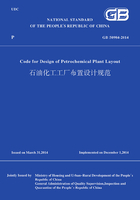
3.4 External Transportation
3.4.1 The external transportation mode for the plant shall be determined based on the demands for plant operation and cargo transportation in conjunction with the current local traffic conditions and planning.For revamp(expansion)project,the existing transportation facilities shall be properly used.
3.4.2 The plant transportation quantity and transportation facilities shall be assigned and planned in an integrated way,and the transportation methods selected shall be convenient and economic.
3.4.3 The external transportation conditions shall satisfy the demands for large-size equipment and bulk cargo transportation during plant construction and after the plant is put into operation.
3.4.4 When the plant is adjacent to the navigable river or sea,waterway shall be preferably selected for long distance transportation of bulk cargoes.
3.4.5 The junction of the plant dedicated railway line shall be approved by the railway management authorities,and shall be in accordance with the following requirements:
1 The capacities of the junction station and the railway line shall satisfy the short-and long-term transportation requirements.
2 The dedicated railway line shall be joined at the marshalling station,and shall not intersect with the main track of national railway.
3 The industrial marshalling station should be arranged near to the operation area with large transportation quantity or frequent shunting operation,and should not be arranged in the plant area.
4 The railway transportation activities should be managed by the railway administrations.
5 The design of enterprise private railway shall meet the requirements of the current national standard Code for Design of ClassⅢ、ⅣRailway GB 50012.
3.4.6 Outside fence roads and entrances to plant area shall be in accordance with the following requirements:
1 They shall be planned in an integrated way,and shall be consistent with the current situations and planning for the local urban roads or the industrial park roads.
2 They shall be convenient for cargo transportation,employee commuting and firefighting.
3 Different entrances should be provided for main pedestrian flow and cargo flow,and individual entrance shall be provided for the administrative area.
4 An entrance shall be provided in the orientation towards the external firefighting forces.
5 Individual entrance should be provided for the truck loading/unloading area.
6 The access road should not cross the railway,if crossing is unavoidable,guardrail crossing or flyover crossing shall be provided.
3.4.7 Pipeline conveying method should be preferably selected for external transportation of bulk liquid,and the interconnecting pipeline between plants shall be arranged in accordance with the following requirements:
1 The laying manner for interconnecting pipeline shall be determined based on the number of pipeline,the properties of the fluids in the pipeline,the topographical and geological conditions and land condition.
2 The interconnecting pipeline shall be arranged in the land planned for pipeline installation.
3 On the premise of the assurance of safety and convenient construction,the pipeline with similar services of different plants should be concentrated on the same pipe support.
4 The route for hazardous chemical pipeline should be run in group.
5 The interconnecting pipeline for hazardous chemical handling shall not pass through the unrelated plant area,village,residential communities and public facility area.
6 If the pipeline is routed along the river,lake or sea,measures shall be taken to prevent the leaked combustible liquid and hazardous chemical from flowing into natural waters.
7 The pipeline shall not be run in the poor geological areas such as mudslide,collapse,settlement and mudflow,and shall not be routed in the seismic area jeopardizing the pipeline safety.If the pipeline has to be routed in such areas due to constrains,protection measures shall be taken,and locations shall be properly selected to minimize the routing length.
8 The overhead interconnecting pipeline may be routed along the public roads for patrol inspection and firefighting purposes,otherwise,patrol inspection and firefighting roads in width not less than 4m should be constructed.
9 If the pipeline crosses over railway or road,the clearance height of pipe support shall meet the requirements of the current national standard Code for Design of Oil and Gas Transportation Pipeline Aerial Crossing Engineering GB 50459.
10 When underground pipeline for combustible gas,liquid and hazardous chemical services passes through the public road,railway,flood channel and other underground ditch,it shall meet the requirements of the current national standard Code for Design of Oil and Gas Transportation Pipeline Crossing Engineering GB 50423 and Code for Design of Fire Prevention of Petrochemical Enterprises GB 50160.
3.4.8 Outside fence transportation systems such as road,railway,pipeline and conveying belt shall be planned in an integrated way,and shall be in accordance with the following requirements:
1 Transportation routes shall be properly selected,and shall be convenient and economic.
2 Transportation routes shall be near to the plants with larger transportation quantity.
3 Hazardous chemical transportation routes should be shortened and run in group.
4 Pipe-rack and conveying belt routes should be arranged along the roads,and crossings with roads and railways should be minimized.
5 Crossings between main roads and railways shall be minimized.
6 Running of the railway lines,pipe-racks and conveying belts through the industrial park future land shall be minimized.